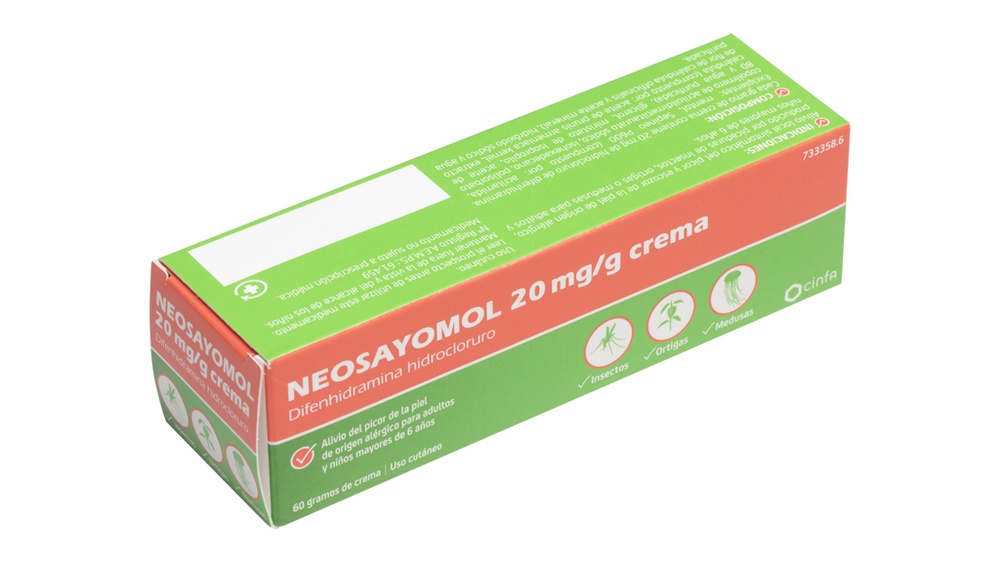

NEOSAYOMOL 20 mg/g CREAM

Ask a doctor about a prescription for NEOSAYOMOL 20 mg/g CREAM

How to use NEOSAYOMOL 20 mg/g CREAM
Introduction
Prospectus: Information for the User
Neosayomol 20 mg/g Cream
Diphenhydramine Hydrochloride
Read this prospectus carefully before starting to use this medication, as it contains important information for you.
Follow the administration instructions for the medication contained in this prospectus or as indicated by your doctor or pharmacist.
- Keep this prospectus, as you may need to read it again.
- If you need advice or more information, consult your pharmacist.
- If you experience adverse effects, consult your doctor or pharmacist, even if they are not listed in this prospectus. See section 4.
- You should consult a doctor if your condition worsens or does not improve after 5 days of treatment.
Contents of the Prospectus
- What Neosayomol is and what it is used for
- What you need to know before starting to use Neosayomol
- How to use Neosayomol
- Possible adverse effects
- Storage of Neosayomol
- Package contents and additional information
1. What Neosayomol is and what it is used for
Neosayomol is a cream composed of an antihistamine, diphenhydramine, which is effective in relieving itching in allergic conditions due to its mechanism of action.
This medication is indicated for adults and children over 6 years old for the local symptomatic relief of itching and skin irritation of allergic origin, caused by insect bites, nettles, or jellyfish.
2. What you need to know before starting to use Neosayomol
Do not use Neosayomol
- If you are allergic to diphenhydramine or any of the other components of this medication (listed in section 6).
- If you are using another medication that contains diphenhydramine or another medication for allergic processes (antihistamines).
- On open wounds or infected skin.
- In children under 2 years old.
Warnings and precautions
Consult your doctor or pharmacist before starting to take this medication.
- It should not be applied to open, eroded, bleeding, or blistered skin, or to extensive areas of the skin.
- Contact with the eyes or other mucous membranes should be avoided. Stop using the medication if a burning sensation, skin rash, or if symptoms persist. If necessary, remove it by washing with water and soap.
- To avoid possible photosensitivity reactions, the treated area should be protected from the action of sunlight.
Children
Its use in children under 6 years old should be assessed, as although absorption is very low, it can cause dry skin and mouth, dilated pupils, urinary retention, increased heart rate, tremors, speech disorders, psychomotor hyperactivity, and somnolence.
Elderly patients (over 65 years old)
Its use in people over 65 years old should be assessed, as they are more sensitive to the adverse effects of this medication.
Using Neosayomol with other medications
Inform your doctor or pharmacist if you are using, have recently used, or may need to use any other medication.
Do not use it with other medications on the same area of skin, or with those that are known to cause allergic reactions on the skin (photosensitivity and phototoxicity), without consulting your doctor.
Although significant absorption is not expected, part of this medication could pass into the bloodstream, so using this medication simultaneously with ototoxic medications (such as some antibiotics) may mask the sensation of dizziness and drowsiness.
Alcoholic beverages should not be consumed during treatment, as simultaneous use may increase the sedative effect.
The use of this medication in conjunction with anticholinergic medications (such as antiparkinsonian, some antidepressants, neuroleptics, and belladonna) and with a medication called metoprolol (to reduce blood pressure and heart disease) may increase adverse effects.
The use of this medication with sedative medications (opioid analgesics, barbiturates, benzodiazepines, antipsychotics) may cause somnolence.
Interference with analytical tests
If you are going to undergo any analytical tests (including blood tests, urine tests, skin tests that use allergens, etc.), inform your doctor that you are taking this medication, as it may alter the results.
Pregnancy, breastfeeding, and fertility
If you are pregnant or breastfeeding, think you may be pregnant, or plan to become pregnant, consult your doctor or pharmacist before using this medication.
Although systemic absorption and passage into breast milk are not expected, pregnant and breastfeeding women should consult their doctor before using this medication.
Driving and using machines
Under approved conditions of use, it is not expected that this medication will affect the ability to drive and use machines.
3. How to use Neosayomol
Follow the administration instructions for the medication contained in this prospectus or as indicated by your doctor or pharmacist. In case of doubt, ask your doctor or pharmacist.
The recommended dose is:
Adults and children over 6 years old
A small amount of medication should be applied to the affected area, up to a maximum of 3-4 times a day.
If symptoms persist for more than 5 days or worsen, discontinue treatment and consult your doctor.
Use in children
Children from 2 to 6 years old:
Children are more prone to adverse effects, so you should consult your doctor about using this medication in children from 2 to 6 years old.
Children under 2 years old
Do not use this medication in children under 2 years old.
If you use more Neosayomol than you should
Overdose is very unlikely due to the form of presentation and dosage. Nevertheless, with excessive or very frequent application, you may notice: dry skin and mouth, dilated pupils, urinary retention, increased heart rate, tremors, speech disorders, psychomotor hyperactivity, sedation, and somnolence. At high doses, coma, ataxia (coordination problems), increased muscle reflexes, and convulsions may appear.
In case of overdose or accidental ingestion, consult your doctor or pharmacist immediately or call the Toxicology Information Service, phone: 91.5620420, indicating the medication and the amount ingested.
If you forget to use Neosayomol
Do not use a double dose to make up for forgotten doses.
Use the dose as soon as possible, or if it is close to the next dose, use it at the usual time, following the normal course of treatment.
If you have any other doubts about using this medication, ask your doctor or pharmacist.
4. Possible adverse effects
Like all medications, this medication can cause adverse effects, although not everyone will experience them.
If you consider that any of the adverse effects you are experiencing is serious or if you notice any adverse effect not mentioned in this prospectus, inform your doctor or pharmacist.
During the period of use of diphenhydramine in topical use, the following adverse effects have been observed, whose frequency has not been established with precision:
- Adverse reactions may be of an allergic type, such as hypersensitivity reactions, as well as skin reactions (photosensitivity and phototoxicity), such as contact dermatitis, pruritus, exanthematous eruptions (redness of the skin), and erythema (skin inflammation) after intense exposure to sunlight.
Reporting adverse effects
If you experience any type of adverse effect, consult your doctor or pharmacist, even if it is a possible adverse effect not listed in this prospectus. You can also report them directly through the Spanish Pharmacovigilance System for Human Use Medications: https://www.notificaram.es. By reporting adverse effects, you can contribute to providing more information on the safety of this medication.
5. Storage of Neosayomol
Keep this medication out of the sight and reach of children.
Do not use this medication after the expiration date that appears on the packaging after CAD. The expiration date is the last day of the month indicated.
This medication does not require special storage conditions.
Medications should not be thrown away through the sewers or in the trash. Deposit the packaging and medications you no longer need at the SIGRE point in the pharmacy. In case of doubt, ask your pharmacist how to dispose of the packaging and medications you no longer need. This way, you will help protect the environment.
6. Package contents and additional information
Composition of Neosayomol
- The active ingredient is diphenhydramine hydrochloride.
- The other components are: menthol, Sepineo P600 (composed of: acrylamide / acryloyldimethyltauric acid sodium copolymer, isohexadecane, polysorbate 80, and purified water), glycerol, isopropyl myristate, calendula oil (composed of: Prunus armeniaca kernel oil, Calendula officinalis flower extract, and mineral oil), sodium hydroxide, and purified water.
Appearance of the product and package contents
Neosayomol is a cream with a bright white color and a mentholated odor.
This medication is presented in a tube containing 30 grams or 60 grams of cream.
Only some package sizes may be marketed.
Marketing authorization holder and manufacturer
Marketing authorization holder
Laboratorios Cinfa, S.A.
Carretera Olaz-Chipi, 10. Polígono Industrial Areta
31620 Huarte (Navarra) – Spain
Manufacturer
Laboratorios Cinfa, S.A.
Carretera Olaz-Chipi, 10. Polígono Industrial Areta
31620 Huarte (Navarra) – Spain
or
BOHM, S.A.
Molinaseca, 23. Pol. Ind. Cobo
28947 Fuenlabrada (Madrid) - Spain
Date of the last revision of this prospectus: February 2022
Detailed information about this medication is available on the website of the Spanish Agency for Medicines and Health Products (AEMPS) www.aemps.gob.es/
- Country of registration
- Active substance
- Prescription requiredNo
- Manufacturer
- This information is for reference only and does not constitute medical advice. Always consult a licensed doctor before taking any medication. Oladoctor is not responsible for medical decisions based on this content.
- Alternatives to NEOSAYOMOL 20 mg/g CREAMDosage form: GEL, 1 mg/gActive substance: dimetindeneManufacturer: Laboratorios Normon S.A.Prescription not requiredDosage form: GEL, 1 mg/gActive substance: dimetindeneManufacturer: Grindeks AsPrescription not requiredDosage form: GEL, 100 mg dimetindene maleateActive substance: dimetindeneManufacturer: Haleon Spain S.A.Prescription not required
Alternatives to NEOSAYOMOL 20 mg/g CREAM in other countries
The best alternatives with the same active ingredient and therapeutic effect.
Alternative to NEOSAYOMOL 20 mg/g CREAM in Ukraine
Online doctors for NEOSAYOMOL 20 mg/g CREAM
Discuss dosage, side effects, interactions, contraindications, and prescription renewal for NEOSAYOMOL 20 mg/g CREAM – subject to medical assessment and local rules.






